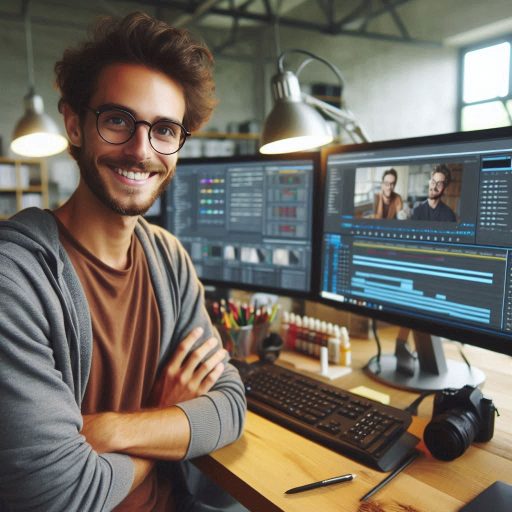Introduction
A multimedia artist creates visual content across various media platforms.
They blend traditional art with digital technology to produce dynamic visuals.
Their work spans digital art, video production, animation, and interactive design.
Multimedia artists work in diverse roles, including graphic designers, animators, and video editors.
As graphic designers, they craft visual elements for websites, advertisements, and print materials.
They ensure that the visual design aligns with the client’s branding and message.
In their role as animators, multimedia artists bring characters and stories to life.
They design animations for films, video games, and online content.
They use software to create and edit animated sequences, ensuring fluid motion and engaging visuals.
Video editors, another key role, focus on assembling video footage into polished final products.
They cut, arrange, and enhance video clips to tell a coherent and compelling story.
Their goal is to create a seamless visual experience for viewers.
Multimedia artists also work on interactive design projects.
They develop user interfaces for apps and websites, ensuring that they are user-friendly and visually appealing.
They test and refine these designs to enhance user experience.
Overall, multimedia artists combine creativity with technical skills.
They adapt to new technologies and trends to stay relevant in a rapidly evolving field.
Their work requires both artistic vision and technical proficiency to produce engaging multimedia content.
Morning Routine
Typical morning activities of a multimedia artist
As a multimedia artist, my typical morning starts with a cup of coffee to fuel my creativity.
I believe in setting the right tone for the day by immersing myself in a creative mindset from the moment I wake up.
Transform Your Career Today
Unlock a personalized career strategy that drives real results. Get tailored advice and a roadmap designed just for you.
Start NowI begin my day by checking emails and messages to stay connected with clients and collaborators.
Next, I spend some time brainstorming ideas for my current projects or upcoming assignments.
Stretching and a quick workout help me get energized and ready for a day filled with creativity.
Setting goals for the day is crucial to ensure that I stay focused and productive throughout my work hours.
Before diving into work, I like to review my schedule and prioritize tasks based on deadlines and importance.
Importance of starting the day with creativity in mind
Starting the day with a creative mindset is essential for a multimedia artist.
It allows me to approach my work with fresh ideas and innovative solutions.
By incorporating creative activities into my morning routine, I set the tone for a day filled with artistic exploration and experimentation.
Read: Top Online Courses for Multimedia Art and Design
Project Management
How a multimedia artist organizes their projects
Organizing projects is a crucial aspect of a multimedia artist’s workflow.
Here’s how they go about managing their projects:
- Creating a project timeline to track progress and deadlines
- Breaking down tasks into smaller, manageable chunks
- Setting goals and milestones to stay on track
- Collaborating with team members to delegate tasks effectively
- Regularly reviewing and adjusting the project plan as needed
Common Tools and Software for Project Management
Multimedia artists rely on a variety of tools and software to streamline their project management process.
Some common ones include:
- Project management software such as Trello or Asana
- Collaboration tools like Google Drive or Dropbox
- Communication platforms such as Slack or Microsoft Teams
- Design tools like Adobe Creative Suite for creating assets
- Time tracking apps to monitor progress and billable hours
Read: Creative Display Ideas for Visual Merchandisers
Creative Process
Steps involved in the creative process of a multimedia artist
A multimedia artist’s creative process begins with inspiration.
Ideas can stem from everyday experiences, observations, or personal emotions.
The artist may jot down thoughts or create sketches to visualize concepts.
These initial ideas help shape the direction of the project.
Next, the artist conducts research. They explore relevant themes, historical contexts, and technical requirements.
Research deepens their understanding and enriches the creative vision.
Transform Your Career Today
Unlock a personalized career strategy that drives real results. Get tailored advice and a roadmap designed just for you.
Start NowGathering references and inspirations often leads to more refined ideas.
The conceptualization phase follows. Here, the artist drafts detailed plans, such as storyboards or mockups.
This step outlines how various elements will work together.
It sets the foundation for the artistic creation, ensuring coherence and clarity.
Execution is the next crucial stage. The artist begins crafting the project using different tools and mediums.
They might use digital software, traditional painting techniques, or sculptural methods.
Each medium contributes uniquely to the overall outcome.
How ideas are developed and implemented through various mediums
During the creation, the artist frequently revisits and refines their work.
They assess how well the elements align with the original concept.
Adjustments are made to enhance visual appeal, functionality, or narrative impact.
This iterative process helps achieve the desired effect.
Collaboration often plays a role. The artist might seek feedback from peers or clients.
Constructive criticism provides fresh perspectives and helps improve the project.
Effective communication ensures that the final product meets the intended goals.
Finally, the project reaches completion. The artist reviews the work to ensure it fulfills the initial vision.
They prepare the project for presentation or publication.
This might involve formatting for digital platforms or preparing physical displays.
In summary, a multimedia artist’s creative process involves a blend of inspiration, research, conceptualization, execution, and refinement.
Each step is crucial in developing and implementing ideas through various artistic mediums.
Read: Job Outlook for Multimedia Artists and Designers
Transform Your Career Today
Unlock a personalized career strategy that drives real results. Get tailored advice and a roadmap designed just for you.
Start Now
Collaboration and Communication
Importance of working with others in the field of multimedia art
In multimedia art, collaboration and communication are essential.
Artists work closely with other creatives to bring projects to life.
Effective teamwork ensures the final product meets the client’s vision and expectations.
Multimedia artists often collaborate with graphic designers, animators, and programmers.
For example, in game design, an artist might create characters while a programmer develops the game mechanics.
Their combined efforts create an engaging gaming experience.
Artists also work with clients to understand their needs.
Clear communication helps artists grasp the client’s vision and preferences.
This process involves regular meetings and feedback sessions to ensure alignment.
Examples of how multimedia artists collaborate with colleagues and clients
In advertising, multimedia artists might collaborate with copywriters and marketers.
They work together to create compelling visuals that complement written content.
This collaboration enhances the overall impact of the advertisement.
During the production of a film or video project, artists coordinate with directors, producers, and editors.
They provide visual elements that align with the film’s narrative.
Effective communication helps ensure the visuals support the storyline and meet production deadlines.
In web design, multimedia artists collaborate with developers to create interactive elements.
Artists design the visual aspects while developers handle the technical implementation.
This teamwork results in functional and visually appealing websites.
Collaborative tools like project management software facilitate communication.
These tools help team members share ideas, track progress, and provide feedback.
Transform Your Career Today
Unlock a personalized career strategy that drives real results. Get tailored advice and a roadmap designed just for you.
Start NowThey streamline the workflow and keep everyone on the same page.
Successful collaboration in multimedia art depends on openness and adaptability.
Artists must be willing to incorporate feedback and adjust their work accordingly.
By working together, they achieve a unified vision and produce high-quality results.
Effective communication and collaboration are crucial in multimedia art.
They enable artists to blend their skills with those of others, creating cohesive and impactful projects.
Read: Visual Merchandising: Importance in Retail Success
Problem-solving and Adaptability
Challenges that multimedia artists face in their work
Being a multimedia artist comes with its fair share of challenges that require problem-solving skills and adaptability.
Here are some of the common challenges faced by multimedia artists:
- Tight Deadlines: One of the biggest challenges for multimedia artists is working under tight deadlines to deliver projects on time.
- Technical Issues: Dealing with technical glitches and software malfunctions can cause delays in completing projects.
- Creative Blocks: Multimedia artists often face creative blocks when trying to come up with innovative ideas for their work.
- Client Feedback: Interpreting and incorporating client feedback can sometimes be challenging, as it may conflict with the artist’s vision.
Problem-solving skills and adaptability required in this profession
To overcome these challenges, multimedia artists need to possess strong problem-solving skills and adaptability.
Here’s how they can navigate through these obstacles:
- Effective Time Management: By prioritizing tasks and creating a realistic schedule, multimedia artists can meet tight deadlines without compromising on the quality of their work.
- Continuous Learning: Staying updated with the latest software and tools in the multimedia industry can help artists troubleshoot technical issues more efficiently.
- Exploring Different Styles: To overcome creative blocks, multimedia artists can experiment with different styles and techniques to spark new ideas.
- Effective Communication: Clear communication with clients is crucial to understanding their feedback and making necessary adjustments to the project.
- Collaboration: Working with other artists or creative professionals can offer fresh perspectives and solutions to challenges faced in multimedia projects.
Overall, being a multimedia artist requires not only technical skills but also the ability to think on your feet and adapt to changing circumstances.
By honing their problem-solving skills and remaining flexible in their approach, multimedia artists can overcome any obstacles that come their way.
Networking and Professional Development
Role of Networking in the Career of a Multimedia Artist
Networking plays a crucial role in the career of a multimedia artist.
It allows them to connect with other professionals in the industry, share ideas, collaborate on projects, and gain exposure to new opportunities.
Building a strong network can open doors to new clients, potential collaborations, and valuable connections that can help advance their career.
Tips for Professional Development and Continuing Education in the Field
Attend Workshops and Conferences
Participating in workshops and conferences related to multimedia art can help artists stay updated on industry trends, techniques, and tools.
It also allows them to network with other professionals and gain insights into different approaches to their work.
Online Courses and Tutorials
With the rise of online learning platforms, multimedia artists can take advantage of courses and tutorials to enhance their skills and knowledge.
These resources offer flexibility and convenience, allowing artists to learn at their own pace and schedule.
Transform Your Career Today
Unlock a personalized career strategy that drives real results. Get tailored advice and a roadmap designed just for you.
Start NowJoin Professional Associations and Organizations
Being part of professional associations and organizations dedicated to multimedia arts can provide artists with access to valuable resources, networking opportunities, and industry events.
It also helps them stay connected with the latest developments in the field.
Collaborate with Peers and Mentors
Collaborating with fellow artists, designers, and mentors can be a great way to learn new techniques, gain feedback on their work, and expand their creative horizons.
Working with others can inspire fresh ideas and help artists grow professionally.
Create a Portfolio and Online Presence
Building a strong portfolio showcasing their best work is essential for multimedia artists to attract potential clients and employers.
Maintaining an online presence through a personal website or social media platforms can help artists showcase their skills and reach a wider audience.
Stay Updated on Technology and Tools
Technology in the multimedia industry evolves rapidly, so it’s crucial for artists to stay up-to-date on the latest software, tools, and techniques.
Regularly updating their skills and knowledge can help them remain competitive in the field and adapt to new trends.
Seek Feedback and Critique
Constructive feedback and critique from peers, mentors, and clients can help multimedia artists improve their work and grow professionally.
Being open to feedback, learning from it, and incorporating suggestions can help artists refine their skills and develop their style.
Attend Networking Events and Industry Mixers
Networking events, industry mixers, and art exhibitions provide opportunities for multimedia artists to meet industry professionals, potential clients, and collaborators.
Building relationships through face-to-face interactions can lead to new projects, collaborations, and career advancement opportunities.
By prioritizing networking and professional development, multimedia artists can continue to grow, expand their skills, and stay competitive in the ever-evolving field of multimedia art.
Conclusion
Being a multimedia artist involves a wide range of creative processes.
From brainstorming ideas to bringing them to life using digital tools and techniques, the day in the life of a multimedia artist is filled with excitement and challenges.
It requires a blend of technical skills, artistic vision, and a passion for experimentation.
As a multimedia artist, you have the opportunity to work on diverse projects, collaborate with other creatives, and constantly evolve your craft.
The key points discussed in this blog post include the importance of creativity, technology, and collaboration in multimedia art.
We encourage readers to explore the diverse and dynamic world of multimedia art, whether through creating their own projects or appreciating the work of others.
Multimedia art offers endless possibilities for expressing ideas and emotions, pushing boundaries, and connecting with audiences in unique ways.
Transform Your Career Today
Unlock a personalized career strategy that drives real results. Get tailored advice and a roadmap designed just for you.
Start NowEmbrace the journey of being a multimedia artist, and let your imagination soar in this ever-evolving field of creativity.
[E-Books for Sale]
The Big Book of 500 High-Paying Jobs in America: Unlock Your Earning Potential
$19.99 • 500 High-Paying Jobs • 330 pages
Explore 500 high-paying jobs in America and learn how to boost your career, earn more, and achieve success!
See All 500 High-Paying Jobs of this E-Book
1001 Professions Without a Degree: High-Paying American Jobs You Can Start Now
$19.99 • 1001 Professions Without a Degree • 174 pages
Discover 1001 high-paying jobs without a degree! Unlock career tips, skills, and success strategies for just $19.99!




